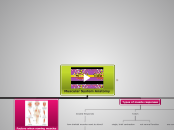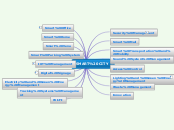combination of ATP + creatine phosphate produces enough energy for 30-40 seconds of heavy activity, beyond that cells need to rely on glycogen
The Muscular System
Nerve Activation + Contraction
Muscle Cell Relaxation
muscle relaxes
thick + thin filaments detach from each other
calcium pumped back into sarcoplasmic reticulum
requires ATP
Muscle Cell Contraction
ATP is required
presence of calcium allows thick + thin filaments to attach + slide past each other
Calcium Release
impulse in muscle cell membrane causes calcium to be released into cytoplasm from sarcoplasmic reticulum
Muscle Cell Activation
release of acetylcholine causes electrical impulse in cell membrane of each muscle cell
Neurotransmitter Release
acetylcholine released at neuromuscular junction
Motor Neuron Activation
brief electrical impulse (action potential) that travels down motor neuron from CNS
Nerve Activation + Force
Muscle Myogram
Tetanus
if stimulation becomes so frequent that muscle cannot relax, it will be in state of maximum contraction
Summation
increasing muscle cell force by increasing rate of stimulation of motor units
force becomes greater because more calcium is present
if additional stimuli arrive at muscle cell before it has a chance to transport calcium back to sarcoplasmic reticulum, total force produced becomes greater than one twitch alone
Relaxation
troponin-tropomyosin complex shifts back to original position + sarcomere stretches passively to original length
calcium transported back into sarcoplasmic reticulum
Contraction
actin filaments are pulled toward centre of sarcomere by sliding filament mechanism (shortening)
Latent Period
time it takes for nerve impulse to travel to sarcoplasmic reticulum, calcium to be released + for myosin to bind to actin
time delay b/w neural stimulation + start of contraction
Muscle Tone
force generation by a muscle is the frequency of stimulation of individual motor units
increasing tone by activating more motor units is called recruitment
exists because at any one time, some muscles motor units are contracting while others are relaxed
intermediate level of force maintained in whole muscles
All Or None Principle
mucle cells always respond with a complete cycle of contraction + relaxation (twitch) every time they are electrically stimulated by an action potential
muscle cells are completely under the control of their motor neuron
Motor Unit
larger units generate more force but offer less control
smallest functional unit of muscle contraction because as the motor neuron is activated, all muscle cells in that motor unit are activated together
Muscle Tension
amount of tension depends on # of muscle cells in motor unit, # of motor units active + frequency of stimulation of individual motor units
mechanical force that muscle generate when they contract
Nerve Activation + Ca Release
Calcium Initiating Sliding Filament Mechanism
troponin-tropomyosin complex is closely associated with actin filaments + are involved in initiating contraction
in presence of Ca, Ca binds to troponin to shift the complex to expose myosin binding sites + permits the formation of cross bridges
in the absence of Ca, it interferes w/ myosin binding sites on actin
sarcomeres shorten when thick + thin filaments slide past each other
every thin filament consists of 2 actin molecules intertwined + myosin thick like a golf club head
4. calcium diffuses into cytoplasm + comes in contact w/ myofibrils + leads to contraction
3. arrival of impulses triggers release of calcium from sarcoplasmic reticulum
sarcoplasmic reticulum must fit into small amount of space in cell not occupied by myofibrils
function is to store Ca
2. binding site causes cell membrane to generate electrical impulse that travels in all directions through T-Cells
function on T tubules is to get electrical impulse to all parts of cell as quickly as possible
1. electrical impulse arrives at junction, acetylcholine is released + diffuses across narrow spece b/w neuron + muscle cell + binds to receptor sites on muscle cell membrane
skeletal muscles stimulated to contract by motor neurons
junction b/w motor neuron + skeletal muscle cell is a neuromuscular junction
motor neurons secrete acetylcholine
excites skeletal muscle cells
neurotransmitter that has either excitatory or inhibitory effects on cell
Skeletal Muscles
Insertion of A Muscle
farther from the midline of the body
other end of a muscle that attaches to another bone across a joint
Origin of A Muscle
when a muscle contracts, the insertion is pulled toward the origin
closer to the midline of the body
one end of a skeletal muscle that joins to a bone that is relatively stationary
few attach to other muscles or to skin (smile muscles)
attach to bones via tendons
Major Skeletal Muscle Groups
Posterior Muscle Groups
Achilles Tendon
connects gastrocnemius muscle to heel
Gastrocnemius
bends foot away from knee
Hamstring Group
bends knee
draws thigh backward
Gluteus Maximus
extends thight
Latissimus Dorsi
rotates + draws arem backward + toward bodt
Triceps Brachii
straightents forearm at elbow
Trapezius
draws head back
braces shoulder
lifts shoulder blade
Deltoid
raises arm
Anterior Muscle Groups
Tibialis Anterior
flexes foot toward knee
Quadriceps Group
extends leg at knee
flexes thigh at hips
Sartorius
rotates thigh outward
bends lower leg at knee
bends thigh at hip
Adductor Longus
draws thigh toward body
rotates thigh laterally
flexes thight
External Oblique
lateral rotation of trunk
Rectus Abdominus
compresses chest cavity
bends back bonde
compresses abdomen
Biceps Brachii
bends forearm at elbow
Serratus Anterior
draws shoulder blade forward
contributes to pushes
helps raise arm
Orbicularis Oris
kissing + whistling muscle
closes lips
Pectoralis Major
draws arm forward + toward body
Masseter
closes the jaw
Exercise Training
Aerobic Training
number of blood capillaries supplying muscle increases as well as mitochondria + myoglobin
activities in which the body increases its oxygen intake to meet increased demands for oxygen by muscles
builds endurance
Strength Training
increases size of individual muscle cells + builds muscle mass + muscle strength
DOES NOT increase # of muscle cells
builds more myofibrils in fast twitch fibres
causes fast twitch fibres to store more glycogen + creatine phosphate as quick energy sources
short, intense exercises like weightlifting
involves doing exercises that strengthen specific muscles usually by providing resistance that makes them work harder
Slow-Twitch vs. Fast-Twitch Fibres
Fast-Twitch Fibres
used for lifting weights or swinging a tennis raquet
store large amounts of glycogen + rely heavily on creatine phosphate + anaerobic metabolism for quick bursts of high energy
during anaerobic activities, lactic acid is made + causes fatigue
depend on aerobic metabolisms for any activity sustained, but have capability of using anaerobic mechanisms for brief periods when bursts of power are needed
called white muscle
NO myoglobin
have fewer mitochondria + blood vessels
break down ATP quickly
contract quickly
Slow-Twitch Fibres
important for maintaining body posture
offer more endurance
useful for jogging, swimming + biking
red muscle
colour provided from myoglobin + blood vessels
store very little glycogen because they obtain glucose + fatty acids quickly from blood
contain many mitochondria + are well supplied with oxygen
ability to maintain temporary storage of oxygen, reduces need for oxygen from blood stream
store oxygen in myoglobin
tend to make ATP as they need it by aerobic metabolism
contract slowly
break down ATP slowly
Muscle Energy
Muscle Fatigue
most common cause is insufficient energy to meet metabolic demands due to the depletion of energy sources in the body
decline in muscle performance during exercise
Aerobic Metabolism
after exercise you still need oxygen to metabolize lactic acid by aerobic pathways to restore muscles stores of ATP + creatine phosphate to their resting levels
rapid breaths help reverse the body's oxygen debt
complete metabolism of 1 glucose yields 36 ATP
always present in the body
increases within several minutes of onset exercise, when blood flow + respiration increase
steady high yield because oxygen + nutrients (glucose + fatty acids) are constantly supplied by the blood
Stored Glycogen
ATP yield depends on oxygen availability
36 can be produced in the presence of oxygen
one glucose can yield 2 ATP in absence of oxygen
primarily used during heavy exercise within the first 3-5 mins
only some muscles store this in large quantities
Stored Creatine Phosphate
converted quickly into ATP
reaction is reversible
if ATP is not needed, excess ATP is used to build fresh supply of creatine phosphate which is stored until needed
can be used for about 30 seconds
3-5x amount of ATP stored
Stored ATP
only direct source of energy
must be replenished by other energy sources
can be used for 10 seconds
stored in small quantities
Muscle Composure
end of a muscle forms together to make tendons that attach muscle to bone
cross section of a muscle reveals it is arranged in fascicles (bundles) enclosed in fascia (sheath of fibrous tissue)
outer surface is also covered by fascia
each fascicle contains a lot of muscle fibres
single muscle is a group of individual cells all with the same origin + insertion + same function
each cell contains more than 1 nucleus
located under cell membrane because entire cell is packed with myofibrils (long cylindrical parallel structures)
segment of a myofibril is from one Z-line to a sarcomere
myofibrils contract + cause muscle to shorten
contractile unit is sarcomere
myofibrils packed with contractile proteins
Myosin
located near centre of sarcomeres + stretching between two actin filaments
thick filaments that are interspersed at regular intervals between paired actin
Actin
structurally linked to Z-line
thin filaments
individual muscle cells are tube shaped + larger + longer than human cells
Muscle Contraction
muscle cells NEVER contract on their own
Isometric Contractions
help stabilize skeleton
sitting in a chair
force is generated, tension increases, but bones + objects don't move
Isotonic Contractions
lifting a weight
when a muscle contracts + maintains a constant force
IMPORTANT FACTORS
when muscle is no longer stimulated, contraction ends
absence of calcium prevents contraction
presence of calcium permits contraction
nerve activation increases concentration of Ca in vicinity of contractile proteins
skeletal muscle must be activated by a nerve
depends on simultaneous shortening of sarcomeres in its cells
Antagonistic Muscle Groups
oppose each other
Muscle Relaxation
as Ca concentration in myofibrils falls, troponin tropomyosin complex shifts back into place + blocks binding sites
occurs when nerve activity ends
means no Ca is released from sarcoplasmic reticulum
Ca released before end of impulses is transported back into the sarcoplasmic reticulum via active transport (requires ATP)
Synergistic Muscle Groups
work together to create the same movement
in absence of contraction, muscles relax + return to their original length
have one basic mechanism (contraction)
muscles are EXCITABLE
contract in response to chemical or electrical signals from organ systems
Muscles Produce Movement or Generate Tension
muscles generate heat
contributes to homeostasis
shivering when its cold outside
when too much heat is produce, the body sweats to release it
contraction of skeletal muscles account for over 3/4 of all heat made by the body
if you faint or collapse, you lose control over muscles that support upright posture
when resisting movement, muscles generate force that exactly opposes equal but opposite force being applied to a body part
maintenance of constant blood vessel even when blood pressure changes is another example of resistance









